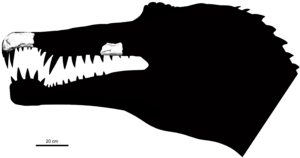Oxalaia facts for kids
Quick facts for kids Oxalaia |
|
|---|---|
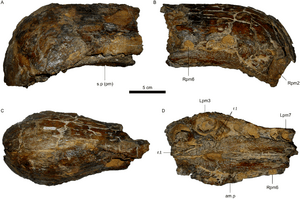 |
|
| Holotype snout in multiple views | |
| Scientific classification |
|
| Kingdom: | Animalia |
| Phylum: | Chordata |
| Clade: | Dinosauria |
| Clade: | Saurischia |
| Clade: | Theropoda |
| Family: | †Spinosauridae |
| Subfamily: | †Spinosaurinae |
| Genus: | †Oxalaia Kellner et al., 2011 |
| Type species | |
| Oxalaia quilombensis Kellner et al., 2011
|
|
| Synonyms | |
|
|
Oxalaia was a huge meat-eating dinosaur. It lived in what is now Brazil, about 100.5 to 93.9 million years ago. We only know about Oxalaia from two skull bones. These bones were found in 1999. Brazilian scientists named this dinosaur in 2011.
It belonged to the Spinosauridae family. These dinosaurs were like crocodiles and ate meat. Oxalaia had a long snout with teeth perfect for catching fish. Its home was a warm, wet place with big forests. Dry deserts were also nearby. Oxalaia lived with many other animals. Many of these animals are also found as fossils in Africa.
Contents
Discovering and Naming Oxalaia
In 1999, two fossil bones from Oxalaia were found. They were in rocks on an island in the Northeast Region of Brazil. This part of the island gets covered by the sea. Waves caused erosion, and the fossils were almost lost. Hundreds of other fossil teeth were also found there.
The full name of the dinosaur is Oxalaia quilombensis. Brazilian palaeontologists Alexander Kellner and his team named it. The first part of the name, Oxalaia, comes from an African god. The second part, quilombensis, comes from quilombos. These were special towns in Brazil.
In 2011, the discovery of Oxalaia was shared with scientists. People are very interested in spinosaurids. This is because they are different from other meat-eating dinosaurs. Also, they are famous from the Jurassic Park movies.
Only two bone pieces from Oxalaia are known. One is the tip of its snout, called the premaxilla. The other is a piece of its left upper jaw, called the maxilla. These two pieces were shown at the National Museum of Brazil in 2011. Sadly, the museum burned down in 2018. The Oxalaia fossils might have been destroyed.
Oxalaia is the third spinosaurid found in Brazil. The other two are Irritator and Angaturama. Angaturama might even be the same animal as Irritator. These two lived about six to nine million years before Oxalaia.
What Oxalaia Looked Like
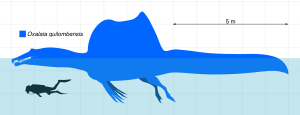
Scientists guessed Oxalaia's size by comparing its bones. They looked at its close relative, Spinosaurus. Oxalaia was probably 12 to 14 meters (39 to 46 feet) long. It likely weighed 5 to 7 tonnes (11,000 to 15,000 pounds). This makes it the biggest meat-eating dinosaur found in Brazil.
The tip of Oxalaia's snout was 201 millimeters (7.9 inches) long. Its whole skull was probably about 1.35 meters (4.4 feet) long. This is shorter than the skull of Spinosaurus, which was 1.75 meters (5.7 feet) long.
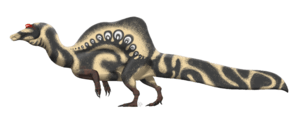
The front of Oxalaias upper jaw was shaped like a spoon. It was wider at the front. The bottom of the snout tip curved inward. This shape fit with its lower jaw, which was also spoon-shaped. The roof of Oxalaias mouth had a strong, bony surface. This made the upper jaw very sturdy for feeding. The fossil snout has wide, deep holes. These likely held blood vessels and nerves.
Oxalaias snout had seven tooth sockets on each side. It had one tooth in each socket. There were also two new teeth growing underneath. These would replace any teeth that fell out. This is common in sharks, but not most meat-eating dinosaurs. Oxalaias teeth were also oval-shaped. Most meat-eating dinosaurs had flatter teeth.
How Oxalaia is Related to Other Dinosaurs
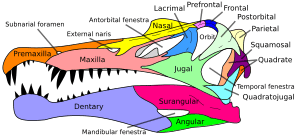
Oxalaia is more closely related to African spinosaurids than Brazilian ones. Oxalaia, Irritator, Angaturama, Ichthyovenator, and Spinosaurus are unique. They are the only known dinosaurs in their group without knife-like teeth. This puts them in their own subgroup, called the Spinosaurinae.
Oxalaia is different from Spinosaurus in its jaw bones. For example, Oxalaia had a rounder snout. Its teeth were also closer together than Spinosauruss. Oxalaias two replacement teeth per socket also make it special.
The diagram below shows how Oxalaia is related to other spinosaurids. It comes from a study by Marcos Sales and Cesar Schultz:
| Spinosauridae |
|
||||||||||||||||||||||||
Oxalaia's Life and Environment
What Oxalaia Ate
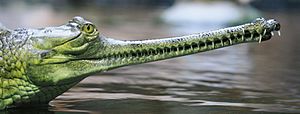
Spinosaurids likely spent most of their time near or in water. They mostly ate aquatic animals like fish. This helped them avoid fighting with other large meat-eating dinosaurs for food. Fossils show that spinosaurs sometimes also ate flying reptiles and small dinosaurs.
Oxalaias cone-shaped teeth were good for spearing prey. They were not for cutting flesh, like most meat-eating dinosaurs. Oxalaias nostrils were set far back on its head. This probably stopped water from getting in when it was fishing. These features were unique to spinosaurids. They helped them catch fish. The spoon-shaped front jaws and sharp teeth worked like a good fish trap. This is also seen in the Indian gharial. This modern crocodile eats mostly fish.
Where Oxalaia Lived

Oxalaia fossils were found in the Alcântara Formation. This is a rock layer in northeastern Brazil. It dates back to the Upper Cretaceous Period, about 100.5 to 93.9 million years ago. Back then, the area had a wet climate. There were large tropical forests. These forests had conifer trees, ferns, and horsetails. Dry lands surrounded these forests.
Oxalaia shared this home with many different animals. Other dinosaurs found there included huge meat-eaters like Carcharodontosaurus, and maybe even Spinosaurus. Smaller predators also lived there. These included dromaeosaurids and an animal like Masiakasaurus. There were also large sauropods. These were plant-eating dinosaurs. Fish found in the area included bony fish, ray-finned fish, and lungfish. Giant coelacanths and sawfishes were also present. Besides dinosaurs, other reptiles lived there. These included pterosaurs and crocodilians. Fossils of snakes and molluscs have also been found.
The animals from the Upper Cretaceous of Brazil are very similar to those from Morocco and Egypt. This is because South America and Africa used to be joined. They were part of a giant supercontinent called Gondwana.
Images for kids
-
Map showing the Northeast Region of Brazil, with the discovery sites of three spinosaurine fossil specimens in the Araripe and São Luís-Grajaú Basins marked. From top to bottom: Oxalaia, Irritator, and Angaturama.
See also
 In Spanish: Oxalaia quilombensis para niños
In Spanish: Oxalaia quilombensis para niños


